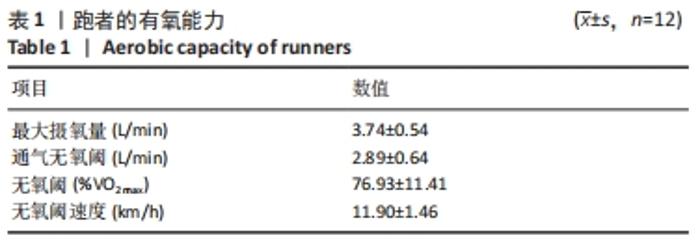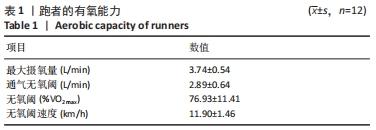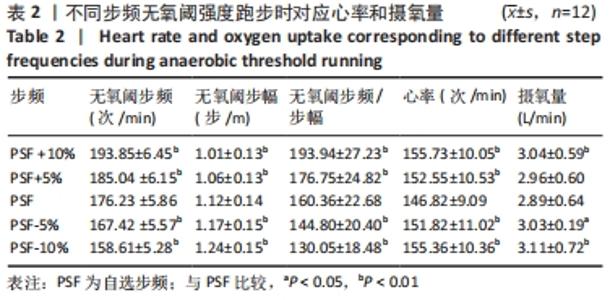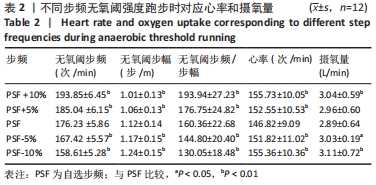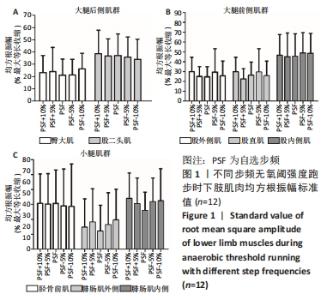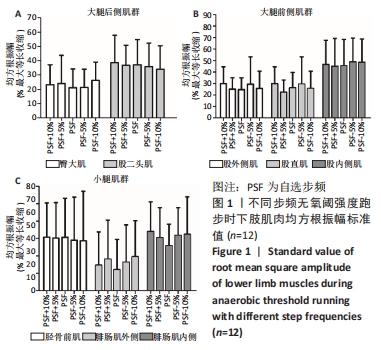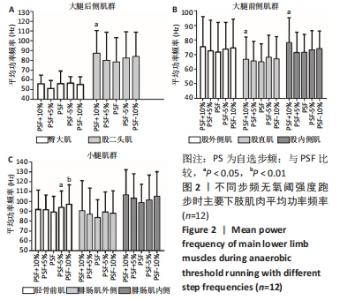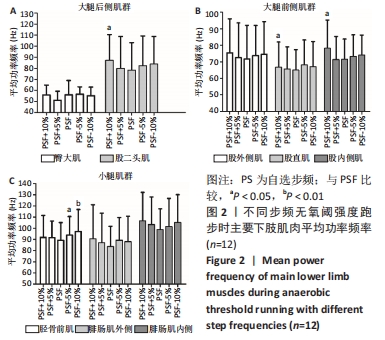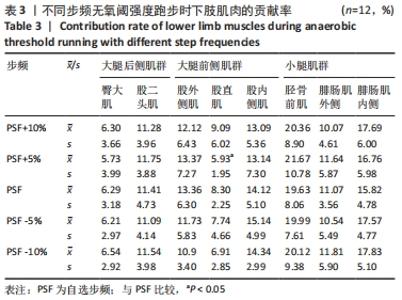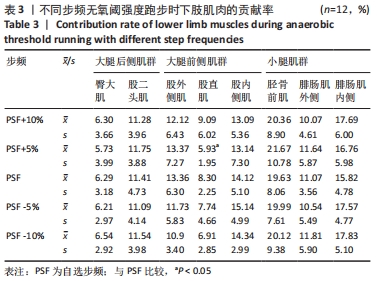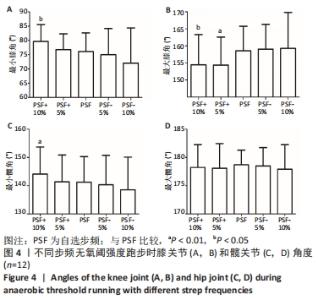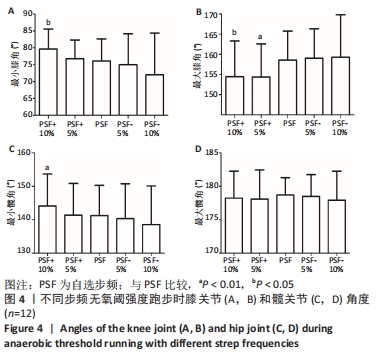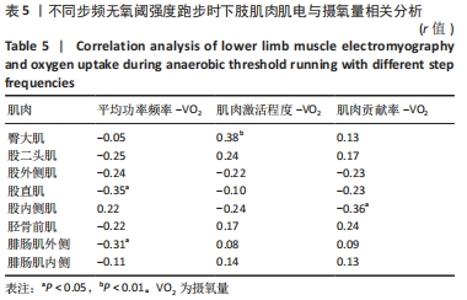Chinese Journal of Tissue Engineering Research ›› 2022, Vol. 26 ›› Issue (26): 4153-4159.doi: 10.12307/2022.817
Previous Articles Next Articles
Changing step frequency influences energy expenditure, surface electromyography, and gait characteristics when running at anaerobic threshold
Li Qinlong, Zhou Yue, Wang Shuo
- School of Human Movement Science, Beijing Sport University, Beijing 100084, China
-
Received:2021-06-09Accepted:2021-07-16Online:2022-09-18Published:2022-03-08 -
Contact:Zhou Yue, PhD, Professor, School of Human Movement Science, Beijing Sport University, Beijing 100084, China -
About author:Li Qinlong, Master candidate, School of Human Movement Science, Beijing Sport University, Beijing 100084, China
CLC Number:
Cite this article
Li Qinlong, Zhou Yue, Wang Shuo. Changing step frequency influences energy expenditure, surface electromyography, and gait characteristics when running at anaerobic threshold[J]. Chinese Journal of Tissue Engineering Research, 2022, 26(26): 4153-4159.
share this article
Add to citation manager EndNote|Reference Manager|ProCite|BibTeX|RefWorks
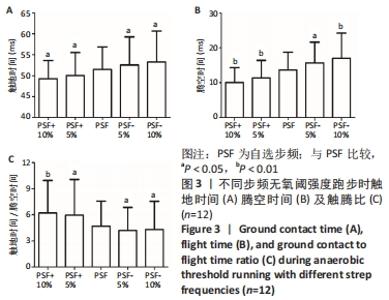
2.5 不同步频无氧阈强度跑步时对步态特征的影响 2.5.1 不同步频无氧阈强度跑时触地、腾空时间及触腾比的变化结果 随着步频提高,触地和腾空时间逐渐减小,触腾比增加;随着步频降低,触地和腾空时间逐渐增加,触腾比减小;具体地,提高步频跑步时,触地时间(P < 0.05)和腾空时间(P < 0.01)都显著小于PSF;PSF+5%(P < 0.05)和PSF+10%(P < 0.01)跑步时,触腾比都显著大于PSF。降低步频跑步时,触地时间显著大于PSF(P < 0.05),触腾比显著小于PSF;当PSF-5%跑步时,腾空时间显著大于PSF(P < 0.05)。当PSF-10%跑步时,腾空时间极显著大于PSF(P < 0.01)。这表明提高步频时,触地时间减小的比例相对小于腾空时间,而降低步频时,腾空时间增加的比例相对大于触地时间,见图3。"

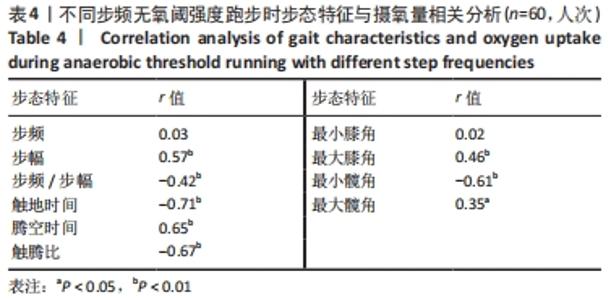
2.6 不同步频无氧阈强度跑步时各项指标与摄氧量相关分析 2.6.1 不同步频无氧阈强度跑步时步态特征与摄氧量相关分析 步态特征与摄氧量进行皮尔逊相关分析发现,步幅与摄氧量呈正相关关系(r=0.57,P < 0.01);步频/步幅比值与摄氧量呈负相关关系(r=-0.42,P < 0.01)。以上结果说明,无氧阈强度下,在PSF-10%至PSF+10%范围内跑步时,跑者的步幅越小,能量消耗可能越少,跑者的步频/步幅越大,能量消耗可能越少。触地时间与摄氧量呈负相关关系(r=-0.71,P < 0.01),腾空时间与摄氧量呈正相关关系(r=0.65,P < 0.01),触地时间/腾空时间与摄氧量呈负相关关系(r=-0.67,P < 0.01),以上结果说明,无氧阈强度下,在PSF-10%至PSF+10%范围内跑步时,跑者的触地时间越长、腾空时间越短、触腾比越大时能量消耗可能越少。最大膝角与摄氧量呈正相关关系(r=0.46,P < 0.01),最小髋角与摄氧量呈负相关关系(r=-0.61,P < 0.01),最大髋角与摄氧量呈正相关关系(r=0.35,P < 0.05),以上结果说明,当髋关节和膝关节活动幅度越小时,能量消耗可能越少,见表4。"
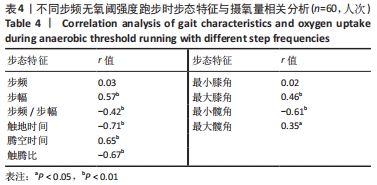
| [1] DE RUITER CJ, VERDIJK PWL, WERKER W, et al. Stride frequency in relation to oxygen consumption in experienced and novice runners. Eur J Sport Sci. 2014; 14(3):251-258. [2] HOBARA H,SATO T,SAKAGUCHI M,et al. Step frequency and lower extremity loading during running. Int J Sports Med. 2012;33(4):310-313. [3] HAFER JF, BROWN AM, DEMILLE P, et al. The effect of a cadence retraining protocol on running biomechanics and efficiency: a pilot study. J Sports Sci. 2015; 33(7):724-731. [4] EDWARDS WB, TAYLOR DT. Effects of stride length and running mileage on a probabilistic stress fracture model. Med Sci Sports Exerc. 2009; 41(12):2177-2184. [5] DEWOLF A, JAEGER DD. Effect of stride length on maximal pelvic tilt and hip extension during running. Comput Methods Biomech Biomed Engin. 2015;18 Suppl 1:1926-1927. [6] THOMPSON MA,GUTMANN A,SEEGMILLER J,et al. The effect of stride length on the dynamics of barefoot and shod running. J Biomech. 2014; 47(11):2745-2750. [7] CHUMANOV ES,WILLE CM,MICHALSKI MP,et al. Changes in muscle activation patterns when running step rate is increased. Gait Posture. 2012;36(2):231-235. [8] HELD NJ, MACLEAN CL, WARBURTON DE. Biomechanical Alterations during Aquatic Treadmill Running. Health Fitness J Canada. 2018;11(4):66-79. [9] 祁钰杰,王琳.跑步再训练对髌股疼痛综合征跑者髌股关节压力的影响[J].浙江体育科学,2021,43(2):105-112. [10] 王俊清,张希妮,罗震,等.步频再训练对跑步时下肢冲击的生物力学影响研究[J].应用力学学报,2020,37(5):2167-2175+2331-2332. [11] LENHART RL, THELEN DG, WILLE CM, et al. Increasing running step rate reduces patellofemoral joint forces. Med Sci Sports Exerc. 2014; 46(3):557-564. [12] ALLEN DJ, HEISLER H, MOONEY J, et al. The effect of step rate manipulation on foot strike pattern of long distance runners. Int J Sports Phys Ther. 2016;11(1):54-63. [13] Santos-Concejero J, Oliván J, Maté-Muñoz JL, et al. Gait-cycle characteristics and running economy in elite Eritrean and European runners. Int J Sports Physiol Perform. 2015;10(3):381-387. [14] Barnes KR, Mcguigan MR, Kilding AE. Lower-Body Determinants of Running Economy in Male and Female Distance Runners. J Strength Cond Res. 2014;28(5):1289-1297. [15] 裴杰,杨建昌.无氧阈测定方法的研究进展[J].首都体育学院学报, 2006, 18(6):68-70. [16] FALLA D, DALL’ALBAA P, RAINOLDI A, et al. Location of innervation zones of sternocleidomastoid and scalene muscles-a basis for clinical and research electromyography applications. Clin Neurophysiol. 2002; 113(1):57-63. [17] GEORGE SM,KARL BL,ADAM RB, et al. Do foot orthoses change lower limb muscle activity in people with flat-arched feet towards a pattern observed in those with normal-arched feet?.Clin Biomech (Bristol, Avon). 2010;25(7):728-736. [18] 刘瑞东,洪扬,陈小平.稳定与多级非稳定条件下徒手与负重深蹲的肌电特征研究及其对当前力量训练的启示[J].体育科学,2015,35(8):45-51. [19] DONATH L, KURZ E, ROTH R, et al. Different ankle muscle coordination patterns and co-activation during quiet stance between young adults and seniors do not change after a bout of high intensity training. BMC geriatrics. 2015;15(1): 1-8. [20] MORGAN DW, BRANSFORD DR, COSTILL DL, et al. Variation in the aerobic demand of running among trained and untrained subjects. Med Sci Sports Exerc. 1995;27(3):404-409. [21] HUNTER I, SMITH GA. Preferred and optimal stride frequency, stiffness and economy: changes with fatigue during a 1-h high-intensity run. Eur J Appl Physiol. 2007;100(6):653-661. [22] LUCA D, CARLO J. Use of the surface EMG signal for performance evaluation of back muscles. Muscle Nerve.1993;16(2):210. [23] GERDLE B, KARLSSON S, CRENSHAW AG, et al. The relationships between EMG and muscle morphology throughout sustained static knee extension at two submaximal force levels. Acta Physiologica Scandinavica. 2010;160(4):341-351. [24] KRISTEV I, KOSSEV A. Muscle fatigue assessment during sustained high isometric contractions. Acta Physiol Pharmacol Bulg. 2001;26(1-2):29-32. [25] 陆阿明,王国栋,王芳. 运动性疲劳对跑运动学与下肢肌电的影响[J]. 体育科学,2012,32(6):44-49,80. [26] MASUMOTO K, JOERGER J, MERCER JA. Influence of stride frequency manipulation on muscle activity during running with body weight support. Gait Posture. 2018;61:473-478. [27] 张美珍,曲峰.跑台和地面上跑动时的生物力学分析[J].北京体育大学学报, 2011,34(11):55-57+61. [28] SANTOS-CONCEJERO J, TAM N, GRANADOS C, et al. Stride Angle as a Novel Indicator of Running Economy in Well-Trained Runners.J Strength Cond Res. 2014; 28(7):1889-1895. [29] 刘智鑫.中长跑技术特征与运动能耗相关性实验分析[J].湖北体育科技, 2018,37(1):28-32. [30] Heise G, Shinohara M, Binks L. Biarticular leg muscles and links to running economy.Int J Sports Med. 2008;29(8):688-691. [31] Neal BS, Barton CJ, Aleksandra B, et al. The effects & mechanisms of increasing running step rate: A feasibility study in a mixed-sex group of runners with patellofemoral pain. Phys Ther Sport. 2018;32:244-251. [32] Heiderscheit BC, Chumanov ES, Michalski MP, et al. Effects of step rate manipulation on joint mechanics during running. Med Sci Sports Exerc. 2011; 43(2):296-302. [33] 王俊清,张希妮,罗震,等. 步频和步长的改变对下肢生物力学的影响研究进展[J].中国运动医学杂志,2020,39(2):138-144. [34] Dickinson MH, Farley CT, Full RJ, et al. How animals move: an integrative view. Science. 2000;288(5463):100-106. [35] Morin JB, Samozino P, Zameziati K, et al. Effects of altered stride frequency and contact time on leg-spring behavior in human running. J Biomech. 2007; 40(15):3341-3348. [36] Farley CT, González O. Leg stiffness and stride frequency in human running. J Biomech. 1996;29(2):181-186. [37] Giandolini M, Arnal PJ, Millet GY, et al. Impact reduction during running: efficiency of simple acute interventions in recreational runners. Eur J Appl Physiol. 2013;113(3):599-609. |
| [1] | Wang Shuai, Wang Liancheng, Zhang Shuhao, Li Fuli, Dong Jiaxing, Zhang Yajie. Correlation of the electromyography ratio of the paraspinal muscles on the convex and concave sides with Cobb angle, apical vertebra translation, and coronal balance distance in adolescent idiopathic scoliosis patients [J]. Chinese Journal of Tissue Engineering Research, 2022, 26(9): 1402-1406. |
| [2] | Chen Jin, Li Jiabin, Gu Mingxing, Tang Rong, Lu Jianxia. Effect of deep muscle stimulation on psoas surface electromyography and spatiotemporal and kinetic gait parameters in patients with chronic non-specific low back pain [J]. Chinese Journal of Tissue Engineering Research, 2022, 26(18): 2894-2899. |
| [3] | Chen Keyi, Wang Dingxuan, Zhang Mengyao. Low-load compression training of the extremities influences surface electromyography and isokinetic flexor and extensor strength of core muscles [J]. Chinese Journal of Tissue Engineering Research, 2022, 26(17): 2744-2748. |
| [4] | Shang Wandi, Wang Xingze, Wei Xiaoyan. Effects of different types of abdominal support on lumbar-back muscle surface electromyography signals in people with abdominal obesity [J]. Chinese Journal of Tissue Engineering Research, 2022, 26(11): 1656-1661. |
| [5] | Zhang Peng, Zhang Junxia. Surface electromyography characteristics of lower limbs in heterogeneous gait environment [J]. Chinese Journal of Tissue Engineering Research, 2021, 25(36): 5814-5820. |
| [6] | Jia Xiao, Xue Xiaojing, Kong Zhenxing, Yu Jingjing, Sun Tingting, Zhang Yimin. Anaerobic threshold intensity of adults aged 20 to 29: a speculation based on a 20-meter shuttle run test [J]. Chinese Journal of Tissue Engineering Research, 2021, 25(14): 2231-2235. |
| [7] | Xu Ping, Liang Leichao, Liang Zhenwen, Cai Ming, Chen Bo, Huang Ping, Zhang Linlin. Surface electromyogram features of the lower limb muscles in cerebral palsy children standing and walking on tiptoes [J]. Chinese Journal of Tissue Engineering Research, 2020, 24(23): 3673-3677. |
| [8] | Chen Lingling, Yang Zekun, Sun Jianjun, Zhang Cun. Motion compatibility recognition of walk-aid robot based on multi-scale permutation entropy [J]. Chinese Journal of Tissue Engineering Research, 2019, 23(34): 5473-5478. |
| [9] |
Yuan Wangshu, Chen Lixia, Shen Jianxiong, Wang Hai, Yu Keyi, Liu Ying, Zhou Jingya, Lin Youxi.
Correlation of surface electromyogram signals of the apex vertebral paraspinal muscle with Cobb angle and axial trunk rotation angle in adolescent idiopathic scoliosis patients
[J]. Chinese Journal of Tissue Engineering Research, 2019, 23(24): 3824-3828.
|
| [10] | Li Ying-ying, Peng Li, Bi Chen-chao. Effects of different test programs on the maximal fat oxidation in young females [J]. Chinese Journal of Tissue Engineering Research, 2018, 22(32): 5145-5149. |
| [11] | Sun Ming-yun, Sun Bo, Zhang Xiang, Li Hai-peng. Work efficiency during movement: Detection using energy and biomechanical methods [J]. Chinese Journal of Tissue Engineering Research, 2013, 17(11): 2032-2039. |
| Viewed | ||||||
|
Full text |
|
|||||
|
Abstract |
|
|||||
